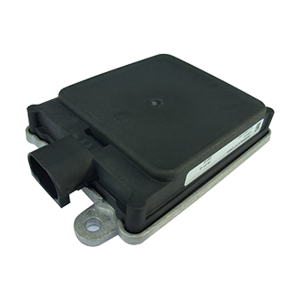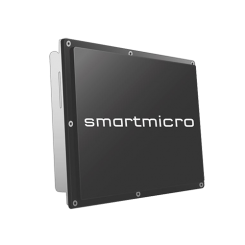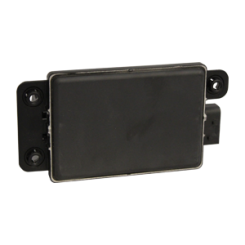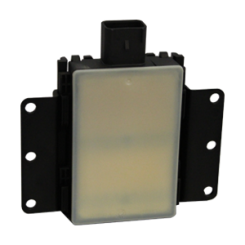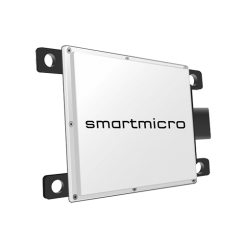Continental ARS 408-21
The Continental ARS 408-21 Radar is preferred with the Baidu Apollo kit. It is fast, safe, reliable and cost-effective and produces real-time distance to object scanning. This radar has a built-in fail-safe that can detect a possible risk of collision (dependent on speed of vehicle) and display it automatically. It works through all weather conditions with a low-performance loss in extreme conditions. Costs are kept low by using Radar technology with less complex measuring principles, development and mass production in the automotive industry.
Features
- The ARS 408-21 provides both excellent measuring performance and reliable operation. This sensor provides real-time object information, such as distance, and is intended to be used for collision mitigation.
- Applicable at all weather conditions and performs well even in extreme situations.
- Self-diagnosing fail-safe operation.
- Produces quality targets, free of false positives, without the use of additional filters.
Specifications
| Measure performance to natural targets (non-reflector targets) | ||
|---|---|---|
| Distance range | 0.20 …250m far range, 0.20…70m/100m@0…±45° near range and 0.20…20m@±60° near range | |
| Resolution distance measuring | point targets, no tracking | Up to 1.79m far range, 0 .39m near range |
| Accuracy distance measuring | point targets, no tracking | ±0.40m far range, ±0.10m near range |
| Azimuth angle augmentation | (field of view FoV) | -9.0°…+9.0° far range, -60°…+60° near range |
| Azimuth beam width (3 dB) | 2.2° far range, 4.4°@0° / 6.2°@±45° / 17°@±60° near range | |
| Resolution azimuth angle | point targets, no tracking | 1.6° far range, 3.2°@0° / 4.5°@±45° / 12.3°@±60° near range |
| Accuracy azimuth angle | point targets, no tracking | 0.1° far range, ±0.3°@0°/ ±1°@±45°/ ±5°@±60°near range |
| Velocity range | -400km/h…+200km/h (- leaving objects…+approximation) | |
| Velocity resolution | target separation ability | 0.37km/h far field, 0.43km/h near range |
| Velocity accuracy | point targets | ±0.1km/h |
| Cycle time | app. 72ms near and far measurement | |
| Antenna channels / -principle | micro stripe | 4TX/2x6RX = 24 channels = 2 TX/6RX far – 2TX/6RX near / Digital Beam Forming |
| Operating conditions | ||
| Radar operating frequency band | cc. ETSI & FCC | 76…77GHz |
| Mains power supply | at 12V DC / 24V DC | +8.0V…32V DC |
| Power consumption | at 12V DC / 10A fuse | 6.6W / 550mA typ. and 12W / 1.0A @max. peak power |
| Load dump protection internal | disconnection >60V and re-start returning to <60V | |
| Operating-/ storage temperature | -40°C…+85°C / -40°C…+90°C | |
| Life time | acc. LV124 part 2 – v1.3 | 1000h or 10 years (for passenger cars) |
| Shock | mechanical | 500m/s2@6ms half-sine (10 x shock each in +/-X/Y/Z dir.) |
| Vibration | mechanical | 20 [(m/s2)2/Hz]@10Hz / 0,14 [(m/s2)2/Hz]@1000Hz (peak) |
| Protection rating | ISO 16750 Classification (Trucks) for vibration | IP 6k 9k (dust, high-pressure cleaning) IP 6k7 (10 cm under water), ice-water shock test, salt fog resistant, mixed gas EN 60068-2-60 |
| Connections | ||
| Monitoring function | self-monitoring (fail-safe designed) | |
| Interface | up to 8 ID | 1 x CAN – high-speed 500 kbit/s |
| Housing | ||
| Dimensions / weight | W * L * H (mm) / (mass) | 38 * 91 * 31 / app. 320g |
| Material | housing front/back cover | BT GF 30 black (BASF-Ultradur B4300G6 LS SW 15073) / AC-47100 (AlSi12Cu1(FE)) die-cast aluminum or EN AW 5754 (3.535) AlMg3 pressed-formed aluminum |
| Miscellaneous | ||
| Measuring principle (Doppler’s principle) in one measuring cycle due basis of FMCW with very fast ramps independent measurement of distance and velocity | ||
| Version ARS 408-21 | sensor for the industry | CAN protocol for free communication |
| The version -21 allows to set maximum 8 ID’s and maximum 8 collision avoidance regions and to change the sensitivity between low and high sensitivity by the user continuously | ||

